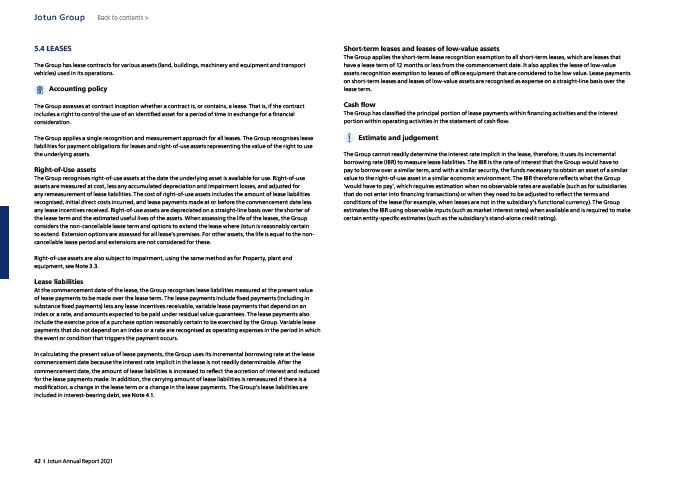
5.4 LEASES
Back to contents >
The Group has lease contracts for various assets (land, buildings, machinery and equipment and transport
vehicles) used in its operations.
Accounting policy
The Group assesses at contract inception whether a contract is, or contains, a lease. That is, if the contract
includes a right to control the use of an identified asset for a period of time in exchange for a financial
consideration.
The Group applies a single recognition and measurement approach for all leases. The Group recognises lease
liabilities for payment obligations for leases and right-of-use assets representing the value of the right to use
the underlying assets.
Right-of-Use assets
The Group recognises right-of-use assets at the date the underlying asset is available for use. Right-of-use
assets are measured at cost, less any accumulated depreciation and impairment losses, and adjusted for
any remeasurement of lease liabilities. The cost of right-of-use assets includes the amount of lease liabilities
recognised, initial direct costs incurred, and lease payments made at or before the commencement date less
any lease incentives received. Right-of-use assets are depreciated on a straight-line basis over the shorter of
the lease term and the estimated useful lives of the assets. When assessing the life of the leases, the Group
considers the non-cancellable lease term and options to extend the lease where Jotun is reasonably certain
to extend. Extension options are assessed for all lease’s premises. For other assets, the life is equal to the noncancellable
lease period and extensions are not considered for these.
Right-of-use assets are also subject to impairment, using the same method as for Property, plant and
equipment, see Note 3.3.
Lease liabilities
At the commencement date of the lease, the Group recognises lease liabilities measured at the present value
of lease payments to be made over the lease term. The lease payments include fixed payments (including in
substance fixed payments) less any lease incentives receivable, variable lease payments that depend on an
index or a rate, and amounts expected to be paid under residual value guarantees. The lease payments also
include the exercise price of a purchase option reasonably certain to be exercised by the Group. Variable lease
payments that do not depend on an index or a rate are recognised as operating expenses in the period in which
the event or condition that triggers the payment occurs.
In calculating the present value of lease payments, the Group uses its incremental borrowing rate at the lease
commencement date because the interest rate implicit in the lease is not readily determinable. After the
commencement date, the amount of lease liabilities is increased to reflect the accretion of interest and reduced
for the lease payments made. In addition, the carrying amount of lease liabilities is remeasured if there is a
modification, a change in the lease term or a change in the lease payments. The Group’s lease liabilities are
included in interest-bearing debt, see Note 4.1.
Short-term leases and leases of low-value assets
The Group applies the short-term lease recognition exemption to all short-term leases, which are leases that
have a lease term of 12 months or less from the commencement date. It also applies the lease of low-value
assets recognition exemption to leases of office equipment that are considered to be low value. Lease payments
on short-term leases and leases of low-value assets are recognised as expense on a straight-line basis over the
lease term.
Cash flow
The Group has classified the principal portion of lease payments within financing activities and the interest
portion within operating activities in the statement of cash flow.
Estimate and judgement
The Group cannot readily determine the interest rate implicit in the lease, therefore, it uses its incremental
borrowing rate (IBR) to measure lease liabilities. The IBR is the rate of interest that the Group would have to
pay to borrow over a similar term, and with a similar security, the funds necessary to obtain an asset of a similar
value to the right-of-use asset in a similar economic environment. The IBR therefore reflects what the Group
‘would have to pay’, which requires estimation when no observable rates are available (such as for subsidiaries
that do not enter into financing transactions) or when they need to be adjusted to reflect the terms and
conditions of the lease (for example, when leases are not in the subsidiary’s functional currency). The Group
estimates the IBR using observable inputs (such as market interest rates) when available and is required to make
certain entity-specific estimates (such as the subsidiary’s stand-alone credit rating).
Jotun Group
42 I Jotun Annual Report 2021